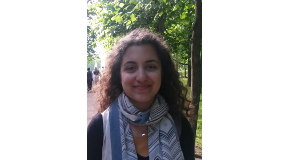
SENA KAYASÜ (ARCH/IV)
sena.kayasu@ug.bilkent.edu.tr
If you’ve seen Pixar’s “Wall-E”—which I would highly recommend you do if you haven’t—there’s a good chance that you’ll feel a tinge of guilt mixed with sadness during the introduction scene, which depicts a small, sympathetic robot building a replica of New York City from squished cubes of garbage 700 years in the future. It may even make you feel some helplessness, because you know we’re ejecting tons of garbage per person per year and there’s not much we can do about it.
Except you’re wrong. The future is not inevitable. There are a lot of ways to deal with garbage, but stacking it up is not one of them. What we’re doing right now (for the most part) is dumping waste in landfills. We dig a big hole in the ground and put all our unwanted stuff there. When the hole is full, we cover it up. It’s like it never existed.
Except it’s not. It poisons the soil and leaks methane (harmful and explosive) into its surroundings. So some people started saying, “Let’s burn it.” What the eye doesn’t see, the heart doesn’t grieve over. But incineration still leaves some solid waste while it releases even more toxic gases into the environment (on a larger scale) and uses up fuel that we don’t have. Sure, you can produce some energy in the process, but it’s not very cost effective (when you take environmental costs into account).
I have a great idea instead: Let’s shoot it into space, where we have unlimited landfill sites that we won’t even have to dig!
It’s not even funny. Thankfully, we’ve started to realize that the best way to deal with waste is to not produce it in the first place. This has happened on a significant scale in a small rural settlement in Italy.
When the people of the Tuscan town of Capannori found out that an incinerator was going to be constructed there, they realized that waste reduction was the only way to go. And it worked: total waste production decreased by 82 percent in five years. In 2007, the town declared that by 2020 they would produce none.
The first thing the town council of Capannori did was motivate people to reduce waste on an individual basis. They had agents who went from door to door and made citizens aware of their personal responsibility regarding this communal issue. The municipality then started to make organic waste into compost and to use it on farm fields while simultaneously encouraging people to compost at home. Plus, the council began building a biogas plant as a larger-scale solution for the waste problem: one which would also create jobs. A landfill would have used up the land occupied by the plant, and only been a finite solution. To the town’s industrial plants, the municipality began to sell recycled materials. All of this saved Capannori 2 million euros in 2009 alone.
Reusing and sharing is a good way to produce less garbage. Why should every house have a bike pump or a shovel? There’s a lot of stuff we don’t need every day. There are also a great number of people who would be willing to repair or reuse stuff we don’t want anymore. Capannori encourages its people to learn how to fix things so that they don’t have to throw them out.
They also provide incentives to local businesses to encourage people to reuse things like liquid detergent bottles—the business fills up the bottle instead of giving the customer a new one. Especially in small places like villages (or walkable communities), packaging may easily be reused rather than thrown away. The council in Capannori took this a step further via “The Short Chain.” Here, the citizens essentially cut out the middlemen (large packaging and distribution companies) and obtain their own food and drink from local farmers. For example, two milk-refill stations were opened where local dairy farmers could bring their product in huge cans, and inhabitants come to refill bottles for themselves. The customers now pay less since new packaging is no longer necessary, and the local farmers earn more since whatever the inhabitants pay goes directly to them.
We can do something similar in Ankara. We can plan for biogas plants or places where local farmers can sell their products, even in Haller near Atatürk Orman Çiftliği, so that it will not only be select restaurants or food centers that buy from farmers, but individuals too. We can also make available to shoppers canvas bags instead of disposable ones.
The main obstacle we have is that Ankara is not exactly rural Italy. An urban population is not the same as that of a village of a few thousand people, most of whom know each other. There may, for instance, be trust issues at places like The Short Chain’s refill stations. Furthermore, many people (including my parents) do their grocery shopping in an unplanned way and will forget to take canvas bags or nets with them. But I know people who don’t forget, and we could encourage that kind of behavior by putting a price on plastic and paper bags, as well as by creating walkable neighborhoods where people don’t need to drive to the grocery store and where they know the people around them, thus becoming more aware of the way they should act (how other people view us is often a great incentive). We could aim to create cozy, mixed-use neighborhoods in a big city. In Capannori, the volume of waste produced per person dropped by almost 40 percent in eight years. Why shouldn’t we be able to do the same?
